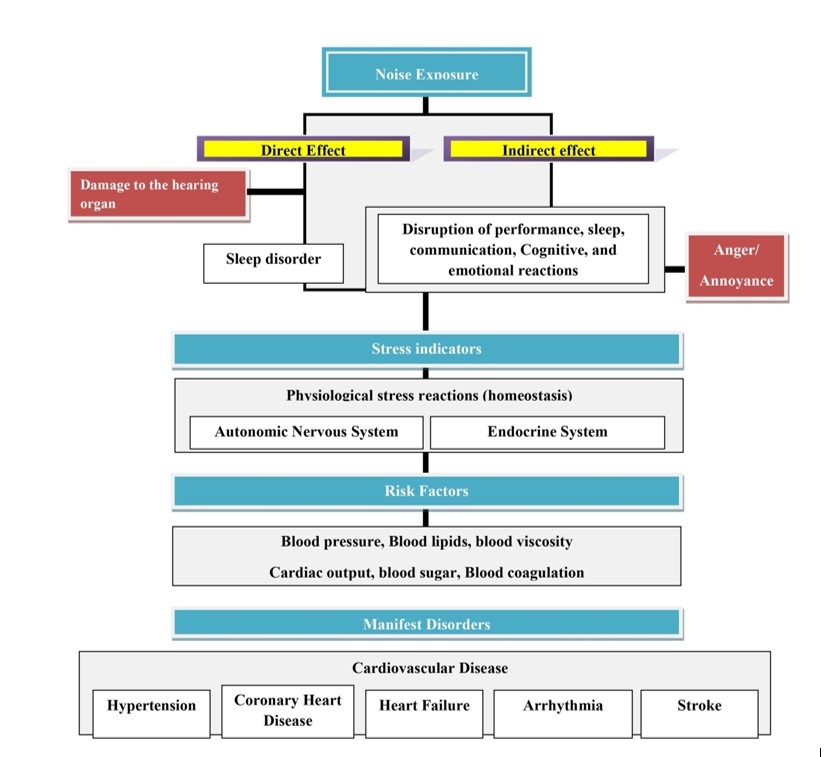Abstract
Loud noises near to the habitat of layer birds result in reduced production, retarded growth and blood pressure may increase leading to hypertension, and weariness. These sounds may be due to the plane in airports, train in railway track, heavy machines at construction sites and other such sources. High noise during the day and night may result in stressed and worried chickens; this is due to the fact that chickens may be aroused from sleep due to the high noises. Though there is no proof that high noises kill the layer birds, those noises have their own effects that are not desired. Even if the pathophysiology is not known, traffic noises can cause chronic stress conditions that result in cardiovascular disease and also affect reproduction. All these suggest that there must be less noise or some means to reduce the noise pollution in and around the habitat of the layer birds.
Key words: Damage, Disease, Layer birds, Noise pollution, Stress
Introduction
Noise can be a stressor for animals and has a significant psychologic component. It can also be a source of dread for animals. Noise has received little research as a stressor in fowls, despite the fact that it appears to have a negative impact on the birds’ productivity and behaviour. The avian species are well adopted to the loud natural noises that are produced by waterfalls or the natural wind, but not to the anthropogenic noise pollution created by man. This is a new factor for the birds and many at times cause health problems to them. In addition to physical damage such as damage to ears and body of the layer birds, studies have revealed that high noise level has its effect on reproductive success rates, behavioural changes, and changes in vocal communication. There are various manifestations that occur in the body due to high noise which includes reduction of feed in take ranging from 15% to 25% during the day time if the noise level is over 85 decibels (dB). This reduction in feed intake has direct effect on the growth of the bird. When the ventilation fan or the machineries in the slaughter house produces more noise resulting in increased level of stress hormones in the bird such as plasma corticosteroids, cholesterol, and other protein levels, So, These high noise may even reduce the economic value of the bird during slaughter. Noise pollution also has its effects on reproduction of the bird and produces noise induced oxidative damage. The effects of noise pollution are of various types (Fig.1).
Effects of Noise Pollution:
Auditory effects:
- Auditory fatigue starts in 90dB and is greatest at 4000 Hz.
- It may cause deafness which may be temporary or permanent. It is termed temporary if recovery occurs within 24 hours and the sound frequency is in the range of 4000 to 6000 Hz.
- Repeated exposure to 100 dB may result in permanent hearing loss. The result may range from small changes in hair cell endings to complete destruction of the Organ of Corti.
- Exposure of noise above 160 dB may lead to the rupture of tympanic membrane in the ear and results in complete hearing loss.
Non-Auditory effects:
- Annoyance that leads to psychological response (irritation, short tempered nature, agitation, disruption of production)
- Affects the efficiency of the bird and leads to decreased work output.
- Physiological changes such as rise in Blood Pressure, Respiratory Rate, and Heart rate. All these result in giddiness and fatigue in the layer birds. High sound levels may also lead to sleep interference and visual disturbance.
- The most important of all effects is the economic loss.
Figure 1: Various manifestations on the health of birds due to high noise level

Loud noises near airports, rail tracks, or loud hydraulic or pneumatic equipment and machinery close to hens have been linked to poorer egg production, stunted growth, elevated blood pressure, stress, and exhaustion. A study discovered that mimicking noisy ventilation fans and operational machineries seen in slaughterhouses resulted in higher plasma cortisone, cholesterol, and total protein levels. According to other studies, noise levels above 85 decibels result in a 15% to 25% reduction in feed intake. Reduced feed consumption slows the growth of chickens, which is something no poultry farmer or processor wants. Controlling noise pollution near hens is clearly advantageous for a variety of reasons. Although the levels of all monitored biochemical indicators were greater in the group of broilers exposed to a higher degree of noise, the influence of varying noise levels was not significant (100 dB). The negative impact of noise exposure on broilers before slaughter should be taken into account, and appropriate technological and organisational safeguards should be implemented, in light of the present increasingly stringent criteria protecting the welfare of animals intended for slaughter.
Various effects on birds can be broadly classified into cardiovascular damage, metabolic damage, and psychological damage. Noise pollution can lead to increased eNOS expression in the bird’s body, but the level of vascular NO is reduced due to eNOS uncoupling. There is also increase in level of IL-6, nitrotyrosine, Nox2 and proteins of endothelin-1. Though high noise levels lead to increased cholesterol and Total proteins in the body, the concentration of glucose and triglycerides is no changed. The tonic mobility is affected in birds that are exposed to noise that are over 80dB. Acute noise exposure had a significant impact on plasma corticosterone levels, which are used as a stress indicator in birds. Sources of noise can be classified as:
- Road traffic noise
- Air traffic noise
- Rail traffic noise
- Domestic noise
- Industrial noise
- Incompatible land use
Ways to minimise noise pollution near habitat of layer:
- Setting the poultry farm in location where there is less chance of noise pollution, i.e., away from railways, airports, and industries.
- Using less noise producing equipment in the poultry farm.
- Regular maintenance of the fans and feeding machines so that they don’t produce much noise.
- Install sound barriers in the windows to reduce the noise that enters through it.
- Active noise control system can be used to produce sound of same amplitude of the noise pollution but the polarity is in contrast to that of the noise pollution thereby cancelling the noise.
Conclusion
Birds in general are also living beings who require the same amenities as human beings, such as a good sleep at night and a pleasant environment during the day for which the noise level must be minimum. If the parameter of excessive noise pollution can be controlled, it will give healthier hens with high production. This in turn is a benefit for both chickens and humans. Common sense and respect are the keys to reduce exposure to noise. Due to the prevalence of noise pollution in many parts of the world, the species-specific noise responses along with their effects are to be understood for controlling the altered environments and for the better health of the birds. It is all about the location of noise pollution equipment and muffling and sheltering chickens from it. Finally, personnel must be taught to take care of the chicken’s sleeping hours which will aid in maintaining the profitability of business.
Reference
- https://www.thepoultrysite.com/articles/how-to-reduce-negative-effects-of-noise-on-chickens
- https://pubmed.ncbi.nlm.nih.gov
- https://www.sciencedirect.com/science/article/abs/pii/S0168159104002163


